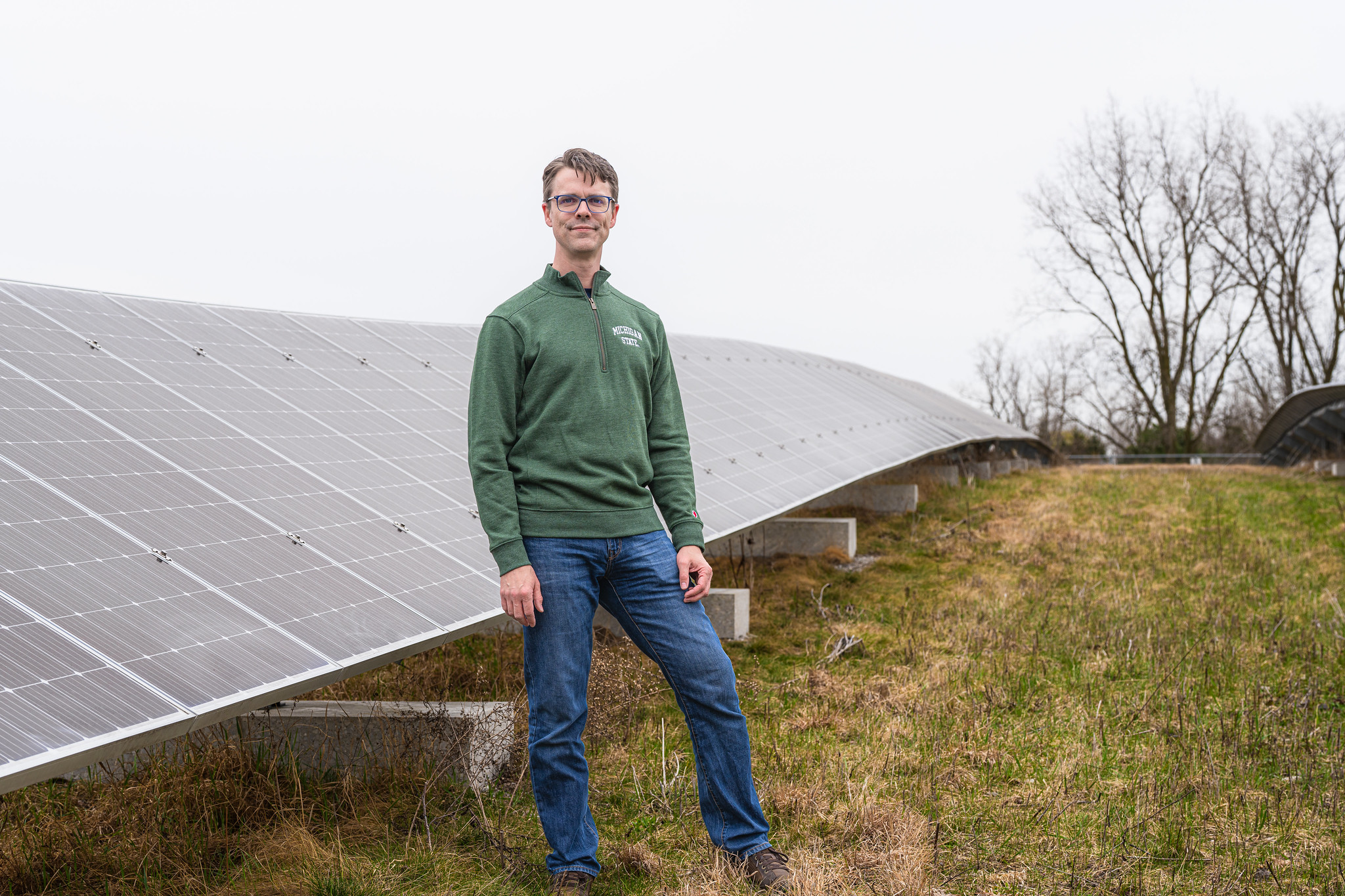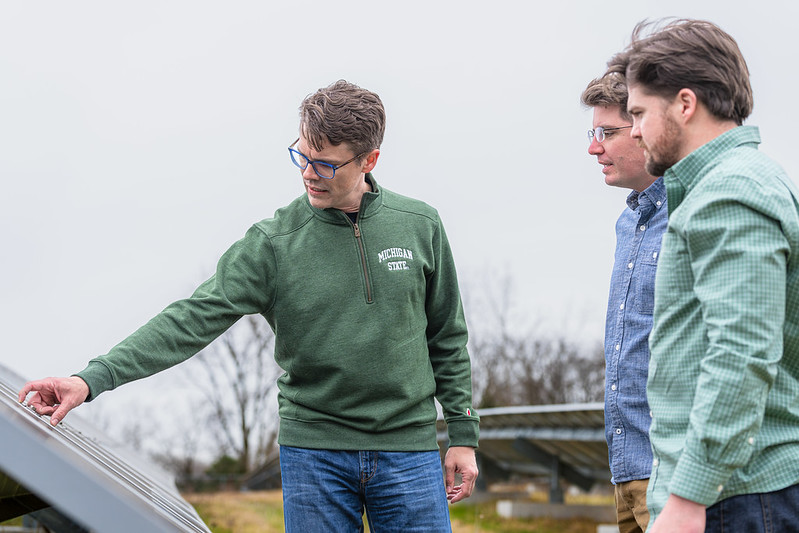Gina and Marc Gigot are the fourth generation to run their family’s western Kansas farm.
The brother-and-sister team took over when their father passed away 10 years ago. They quit their jobs to keep his passion project alive and grow corn on the 9,000-acre property.
Then disappearing groundwater changed everything.
Fifty years ago, Gina Gigot’s father pumped from a groundwater aquifer 80 feet deep to keep his fields irrigated in the Kansas heat and wind. Today, the Gigots must pump from 200 feet to get water. The huge decrease in water levels was a wake-up call.
“We knew that if we did not stabilize the aquifer on our land, it’s not worth anything,” Gina Gigot said. “The land is worthless without water.”
Gina and Marc Gigot overhauled the farm. They switched to growing silage for feeding beef cattle, a crop that needs significantly less water than corn. They updated their center-pivot irrigation system with new technology, drops and nozzle packages that waste less water and measure down to the gallon how much water they’d use. Now, they’re working with Michigan State University and Kansas researchers on a project to make every drop of rain count.
College of Natural Science Assistant Professor Anthony Kendall and College of Engineering Associate Professor Annick Anctil are part of an interdisciplinary team. Together, with Kansas Geological Survey and Kansas State University, they created a system to increase groundwater and preserve aquifers by harnessing the power of solar panel arrays.
Their prototype not only reduces water evaporation by absorbing the sun’s energy and casting shadows, but it also routes water to underground reserves. The aim is to boost how much groundwater farmers have available for irrigation on nearby crops.
Meanwhile, the solar arrays, placed strategically on unproductive field corners, produce energy that farmers can sell to utilities and increase their bottom line.
The team is marrying two entities seemingly at odds with one another — solar panel arrays and agriculture — to instead work in harmony. Their goal is to stop the bleeding for aquifers that are currently on pace to be unusable in 10 to 15 years.
A modest pilot scale pivot-corner solar recharge system is slated to be installed this spring. The team will collect data for three years to determine whether the system improves groundwater recharge on the Gigots’ farm. Eventually, the team hopes to secure a patent on their prototype so that it can be used widely to save water and increase clean energy.
If the project is successful, it could have big implications for farmers in the American West and beyond who are struggling to grow crops in an increasingly hot, dry climate. It could also boost production of food, animal feed and cotton at a time when the global population is exploding.
“We recognize that rural communities in many places are dependent on agricultural income,” Kendall said. “By creating solutions, we can help farmers thrive.”
How solar panels can help recharge groundwater
Center-pivot irrigation is a common practice for farmers in water-stressed areas. This method uses pressure to pump water from a well, spraying it from a pipeline that rotates on wheeled supports around a center point. Fields that use this method are easy to recognize because the irrigated portions look like giant green circles. The pipeline doesn’t reach the corners, so crops often can’t grow there.
Kendall’s hydrogeology lab became interested in using solar panels on these unused corners thanks to a project led by Jake Stid, a postdoctoral fellow in Kendall’s lab. Stid used remote sensing and aerial imagery to study how fields have been used in California for the past 25 years.
He compared farmers who co-located solar arrays alongside crops to those with fields that were entirely agricultural or solar. Among other benefits, Stid found that farmers with both solar arrays and crops saved water by offsetting irrigation.
One reason this happens is solar panels decrease rainwater evaporation. When rain falls, the water only has three options, Kendall said. It can evaporate in sunlight, move as runoff into nearby streams or percolate into the soil as groundwater. Solar panels affect this process by absorbing solar energy, leaving less available for evaporation.
The pivot-corner solar recharge system takes this concept a step further. Anctil, who brings solar energy expertise to the team, designed the solar panels to capture rainwater as well as sunlight.
“Normally, we design solar arrays to maximize how much electricity is being collected,” Anctil said. “But by changing the angle just slightly, you can actually collect a lot more water.”
The system is placed beyond the reach of center-pivot irrigation pipes. The team worked to ensure those areas of the field weren’t producing much to avoid creating long-term issues. They also recruited a Kansas solar vendor for expertise on the local environment and source materials. What’s best for Michigan might not be what’s best for Kansas, she said.
The result is, hopefully, a multipronged positive impact for farmers. By producing electricity, they’re able to buy less electricity from the grid, Anctil said. They’re using less water for irrigation, and they’re producing better crops.
“If you’ve got almost 20% of a field that you’re not using for irrigation, could part of that be used for solar panels?” Kendall said. “If you do that all across the region, can you both generate clean energy and help achieve water sustainability? That’s the basic question.”
MSU’s research got off the ground with the help of a grant from the U.S. Department of Agriculture’s Foundation for Food and Agricultural Research. An even larger, multidisciplinary group also received funding from an MSU Climate Change Research Support Grant. That group includes Bruno Basso, Hanna Distinguished Professor in the departments of Earth and Environmental Sciences and Plant, Soil and Microbial Sciences; M. Charles Gould, an agricultural extension specialist; Nick Haddad, a professor of integrative biology; Doug Bessette, associate professor in the community stability department; Phoebe Zarnetske, a professor of integrative biology; and Adam Zwickle, an associate professor and graduate program director in the community sustainability department.
Why groundwater matters more than ever
Kendall got involved with Kansas researchers about 15 years ago after completing his doctorate when he was looking to do water sustainability work. Like much of the American West, Kansas has water challenges, but it also gets just enough rain that its water could be managed sustainably. He connected with Kansas Geological Survey, or KGS, and researcher Sam Zipper, who is a principal investigator on the solar panel project.
Gina Gigot didn’t think twice when Zipper approached her about participating. She’s willing to try anything to help her with her mission to keep her wells from drying up. That’s not impossible. She’s seen it happen to other farmers who weren’t careful.
While western Kansas boasts fertile soil, the weather isn’t as cooperative. Only about 19 inches of rain fall each year, just half of the 37-inch average on MSU’s campus. If fields aren’t covered by either plants or manure, the soil can quite easily blow away in the near-constant wind.
Aquifers, such as the western Kansas Ogallala Aquifer, have been a reliable source of irrigation since the early 1900s. But Trevor Ahring, a civil engineer from the Southwest Kansas Groundwater Management District No. 3, said water levels have declined over the past 80 years.
Some areas have lost as much as 200 feet of water. Southern communities near the state line might have another century of water left in their aquifers. Further north, some communities could run dry in less than two decades.
“For the people who live here in communities, water gets more valuable every year because it gets scarcer,” Ahring said.
If the aquifers dry up, the western Kansas economy will be forced to change drastically. Not only would farm crops disappear, but insufficient forage, grains and hay would be produced on the Ogallala acres to support the 2 million beef and dairy cattle located there.
Communities could face contamination issues from uranium and nitrates already present in riverbeds, as aquifer water wouldn’t be present to dilute the chemicals. And small communities would struggle to meet drinking water and public safety demands.
The time to act is now, while the aquifers still have water left, Ahring said. Research projects, such as the pivot-corner solar recharge system, could play a role in keeping the aquifers going for future generations.
“Research is critical,” Ahring said. “We have to figure out ways to get more water to return to the ground, and how to do that in a cost-efficient way.”
Already, Gigot has seen farmers dismantle their sprinklers and abandon their fields. What’s left behind is like scorched earth. The land can’t always return to native grass because of the dry weather, and without water, it can’t support development.
The vacant fields remind Gigot of Texas ghost towns.
“When there’s no more water, there’s no more life,” Gigot said.
'This project can help people right away'
While the team waits for the system installation, MSU and Kansas researchers are on the ground collecting field measurements. They’ll use this information along with historical data to measure how well their project is working and hone the system’s design to meet the soil’s unique conditions.
Testing this system in Kansas has a big advantage, Anctil said. Because the state’s growing season is longer and dryer than Michigan, they’ll collect more data and expect to see a bigger difference from their system.
“Doing that scale and testing in real life and collecting data is new, and it’s pretty exciting,” Anctil said. “And if people in Kansas who wouldn’t usually be supportive of solar are excited about it, there’s a good potential for applying the same solution in other places in the country.”
While collecting three years of data, Kendall and his students are developing computer models that could accurately determine other areas where the system could be effective.
The goal is to eventually get the system in the hands of a solar developer. That’s where securing a patent comes in, Kendall said. The team hopes to work with the MSU Innovation Center to help speed up the process of large-scale implementation so that more farmers can see the benefit.
“It’s exciting to think about science making a difference,” Kendall said. “Sometimes our work is foundational and informs future research. But this project can help people right away.”

